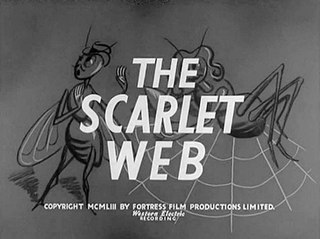
A Time to Kill is a 1955 British second feature ('B') crime film directed by Charles Saunders and starring Jack Watling, Rona Anderson, John Horsley, Russell Napier, Kenneth Kent, and John Le Mesurier. It was written by Doreen Montgomery.

The Girl in the Picture is a 1957 British second feature crime film directed by Don Chaffey and starring Donald Houston and Patrick Holt. It was written by Paul Ryder.

Blood Orange is a 1953 British crime film directed by Terence Fisher and starring Tom Conway and Mila Parély. The screenplay was by Jan Read. A private eye investigating a jewel robbery at a London fashion house finds himself involved in a murder mystery.

The Steel Key is a 1953 British second feature thriller film directed by Robert S. Baker and starring Terence Morgan, Joan Rice and Raymond Lovell.

House of Blackmail is a 1953 British second feature drama film directed by Maurice Elvey and starring Mary Germaine, William Sylvester and Alexander Gauge. It was written by Allan MacKinnon. The plot follows a soldier and his girlfriend, who become mixed up with a blackmailer.

Murder at 3 a.m. is a 1953 British second feature crime film directed by Francis Searle and starring Dennis Price, Peggy Evans and Rex Garner. It was written by John Ainsworth. A Scotland Yard detective investigates a series of attacks on women.

Burnt Evidence is a 1954 British second feature thriller film directed by Daniel Birt and starring Jane Hylton, Duncan Lamont and Donald Gray. It was produced by Ronald Kinnoch for ACT Films.

No Trace is a 1950 British second feature crime film directed by John Gilling and starring Hugh Sinclair, Dinah Sheridan and John Laurie. A crime writer murders a blackmailer, and is then asked to help solve the case by the police.
Three Steps to the Gallows is a 1953 British second feature crime film directed by John Gilling and starring Scott Brady, Mary Castle and Gabrielle Brune. It was released in the US by Lippert Pictures as White Fire.

Recoil is a 1953 British 'B' crime film directed by John Gilling and starring Kieron Moore, Elizabeth Sellars and Edward Underdown.

Never Look Back is a 1952 British second feature ('B') drama film directed by Francis Searle and starring Rosamund John, Hugh Sinclair and Guy Middleton. The screenplay concerns a newly appointed female barrister whose career is threatened by a former lover. It was made by Hammer Films at the Mancunian Studios in Manchester.
Five Days is a 1954 British second feature ('B') film noir directed by Montgomery Tully and starring Dane Clark, Paul Carpenter and Thea Gregory. It was written by Paul Tabori and produced by Anthony Hinds for Hammer Film Productions. It was released in the United States by Lippert Pictures.

Deadly Nightshade is a 1953 British second feature ('B') crime drama film directed by John Gilling and starring Emrys Jones, Zena Marshall and John Horsely. The screenplay was by Lawrence Huntington. A convict on the run switches identities with a lookalike, only to find himself in even deeper trouble.

The Scarlet Web is a 1954 British second feature crime film directed by Charles Saunders and starring Griffith Jones, Hazel Court and Zena Marshall. It was written by Doreen Montgomery.

Counterspy is a 1953 British second feature thriller film directed by Vernon Sewell and starring Dermot Walsh, Hazel Court and Hermione Baddeley. An accountant comes into possession of secret papers sought by both the government and a spy ring.

Johnny on the Spot is a 1954 British 'B' crime drama film directed by Maclean Rogers and starring Hugh McDermott, Elspet Gray and Paul Carpenter. It was written by Rogers based on the 1953 novel Paid in Full by Michael Cronin.

Passport to Treason is a 1956 British second feature mystery thriller directed by Robert S. Baker and starring Rod Cameron, Lois Maxwell, and Clifford Evans. It was written by Kenneth R. Hayles and Norman Hudis, based on the Manning O'Brine novel of the same name.

Profile is a 1954 British second feature ('B') thriller film directed by Francis Searle and starring John Bentley, Kathleen Byron and Thea Gregory. It was written by John Temple-Smith, Maurice Temple-Smith and John Gilling.

13 East Street is a 1952 British second feature ('B') crime thriller film directed by Robert S. Baker and starring Patrick Holt, Sandra Dorne and Sonia Holm. It was written by John Gilling, Carl Nystrom and Baker and produced by Tempean Films.

Dangerous Voyage is a 1954 British crime thriller B film directed by Vernon Sewell and starring William Lundigan, Naomi Chance and Vincent Ball. It was written by Sewell and Julian Ward and was distributed by Anglo-Amalgamated in the UK, and in the United States by Lippert Pictures.


















